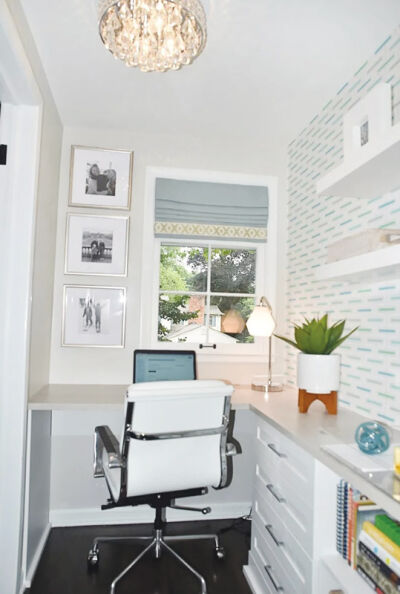
It may not seem like a big deal at first, but reexamining interior design and internet performance can take working at home to the next level.
Photo provided by Corie Conroy
METRO DETROIT — While many of the measures taken during the peak years of COVID-19 have been rolled back, remote working has stuck around.
It may not be for every job and it may be only as much as a day a week, but the staying power of remote working places a new emphasis on the role of the home office. At one point, a laptop and a coffee table was enough for the rare day working from home. Now workers are expected to carry whole meetings over video calls and other such tasks, placing heavy loads on internet usage and requiring a rethinking of interior design.
With video calls being a key part of the work from home package, Corie Conroy, owner of Bloomfield Hills-based First Impression Interior Design, said at-home workers should prioritize their backgrounds.
“You want to make sure your accessories are not personalized, that they’re something that is decorative,” Conroy said. “If you have shelving that calls for accessories, I always say the rule of thumb is you should have something that is large enough to notice on a camera, whether you are taking a photo of a room or you’re on a Zoom meeting, something that is bright enough that it stands out from your shelving, that takes up more of an impact and makes your shelves look fuller, but not too personalized.”
Conroy believes the best place for a home office is along the outer walls of a home or apartment. A window can help with bringing in natural light, while the exterior placement helps separate the office from the home.
“If you have a family and you’re still working when they come home from school or if you have to work on the weekends, something in an outer area of your home is ideal,” Conroy said. “You can close the doors and allow for some quiet space.”
Plants, artwork and other bits of furniture go a long way in making a home office comfortable to work in, but Conroy said the biggest furniture investment at-home workers should make is a comfortable and supportive chair.
“When I shop with clients for chairs for their office, I take them to a few different places to have them sit in it, and I guarantee that the chair that I recommend for them, they will have for a long time,” Conroy said. “It’s not something they’re going to rebuy in the next five years. They’re going to enjoy it and be thankful that they feel OK at the end of the day and that they’re not having back and neck issues because they’re sitting in an uncomfortable spot for eight to 10 hours a day.”
A comfortable chair will help make the home office a space to live in, but letting papers and notes build up on desks and tables will only make the day more stressful. To alleviate stress, Conroy said to pick up a document scanner and begin using digital storage, as well as getting a shredder to dispose of any sensitive documents.
Making a home office look and feel nice is one thing, but a manicured background means nothing if it is a clump of pixels in the background. Making sure a home office has a solid internet connection is critical to video calls and other data-heavy tasks when at home.
“I really encourage everyone who wants to start the process of improving their home networks and their use of the internet to start by plugging in directly,” said Jay Mueller, director of technology for Millennium IT in Livonia. “You can buy a USB-ethernet adapter from anywhere for $10-$20. For network cables, you may already have one in your drawer of tech stuff. Plug it directly into that router, go out to a website like fast.com or speedtest.net and start by getting a baseline. Effectively lay out what your wired performance looks like before trying to troubleshoot (wireless connections).”
Keeping the router in the office and using a direct ethernet connection is the best way to ensure the highest possible internet performance — Mueller said speeds above 100 megabits per second are good and anything below 10 Mbps should be checked out — but directly connecting might not always be possible. Mueller recommends mesh networking as a way to improve internet performance when a direct connection is unavailable.
“The beauty of mesh networking solutions is that you can connect two devices together where it will present the same network, but the different devices will talk one to the other,” Mueller said. “It’s a great way to extend your network without having to do a great deal of trial and error.”
Other ways of indirect connection are available. Powerline adapters allow for an ethernet cable-like connection with a signal sent over electrical wires, while Multimedia over Coax Alliance devices make the connection through TV cable wires. These methods can be cheaper than mesh networking, though possibly at the cost of less reliability.
Getting residential or even commercial-grade fiber optic service may help, though the use-cases for taking a leap this big are highly dependent on the type of work being done. Fiber’s biggest benefit is having symmetrical upload and download speeds, which helps if work requires uploading large, uncompressed files.
Even if a fiber optic connection does not make sense, internet service providers may have plans with stronger service you can receive.
 Publication select ▼
Publication select ▼

























